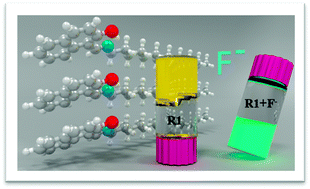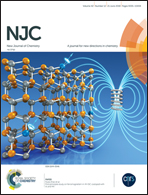Colorimetric and fluorometric turn-on sensor for selective detection of fluoride ions: sol–gel transition studies and theoretical insights†
Abstract
A new organic receptor R1 based on a naphthyl unit covalently linked to a long alkyl chain has been designed, synthesized and characterized by standard spectroscopic techniques. The colorimetric response of receptor R1 from colorless to a pale yellow color and blue fluorescence emission in the presence of F− ions revealed its selective sensing ability in the solution phase. UV-Vis titration, fluorescence titration and 1H NMR titration studies confirmed the formation of the R1–F− complex. Receptor R1 formed a stable gel in DMSO and was confirmed through the standard heating-and-cooling method. Addition of F− ions resulted in disruption of the gel forming a solution that exhibited blue fluorescence emission. The binding constant of the R1–F− complex was found to be of the order of 5.9 × 105 M−1. DFT studies revealed the formation of the receptor–anion complex agreeing well with the experimental results. The detection limit was calculated and found to be 0.8 ppm, implying the potential for application of receptor R1 in environmental applications.



 Please wait while we load your content...
Please wait while we load your content...